I recently won a $100 Amazon Giftcard from MetaCTF’s July Flash CTF. I was trying to figure out: “What should I use it on?” and couldn’t really think of anything I really needed. Then, I remembered last year when I participated in MITRE’s eCTF, which is an embedded capture the flag. I had no prior hardware hacking / embedded system experience, and after the competition, I wanted a way to practice, but didn’t have the proper equipment or tools. So, why not buy a hardware hacking starter kit?
The Kit
My “hardware hacking starter kit” consists of the following items:
- 8ch USB Logic Analyzer (Salea clone)
- CH341A Flash Programmer
- DuPont Wire Kit (120pc)
- FTDI FT232RNL USB to UART
- 4.3” Digital Microscope
- Digital Multimeter
With this, I should be able to (1) analyze signals coming from pins (2) read/write flash memory (depending on the flash memory chip type) (3) get a UART shell (4) determine what pins are UART TX/RX/GND. A pretty barebones kit, but should work nonetheless.
The Target
The target was a TP-Link Tapo model C100. I chose this for a couple reasons. Primarily, it was inexpensive and so if I break something, I can easily replace it. The other being that there’s been a lot of research done on the C200 model, and so I figured I can use that as a reference point if I get stuck anywhere.
The Attack
Opening the Case
With my new C100 in-hand, the first step was to open the case. This was relatively straight forward. I just had to place 4 guitar picks in between the black “lens” and the white plastic shell— one on each side. Then, I just moved them up and down / side to side to try and open any clips that were keeping the housing together. After some movements, the lens shell popped off from the white casing, exposing the chip.
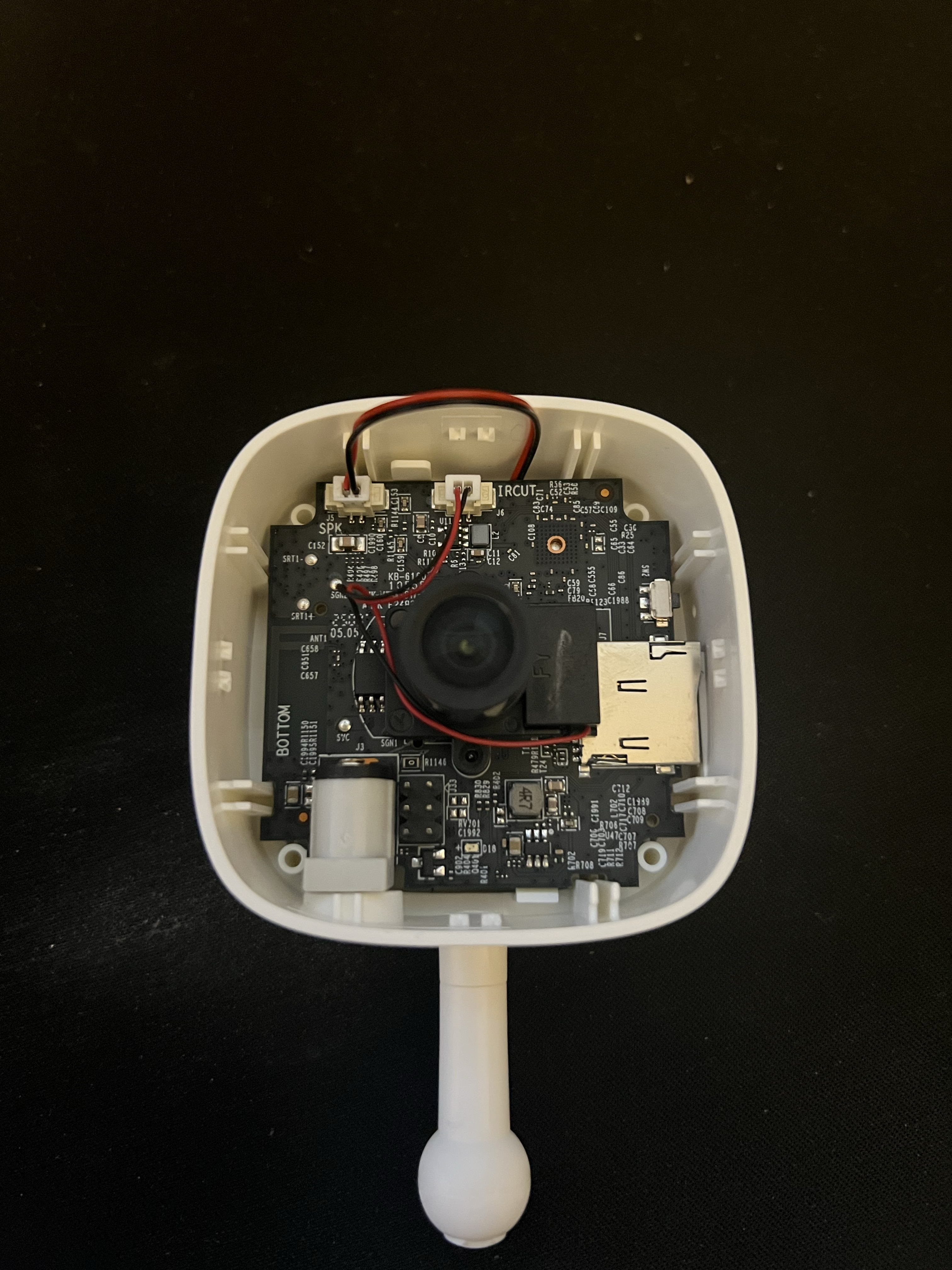
Then, I had to disconnect the cable that connects to the speaker (top left) as the speaker is adhesived to the shell. Doing this and pressing in the clip next to the cable allows us to pull the chip out of the shell.
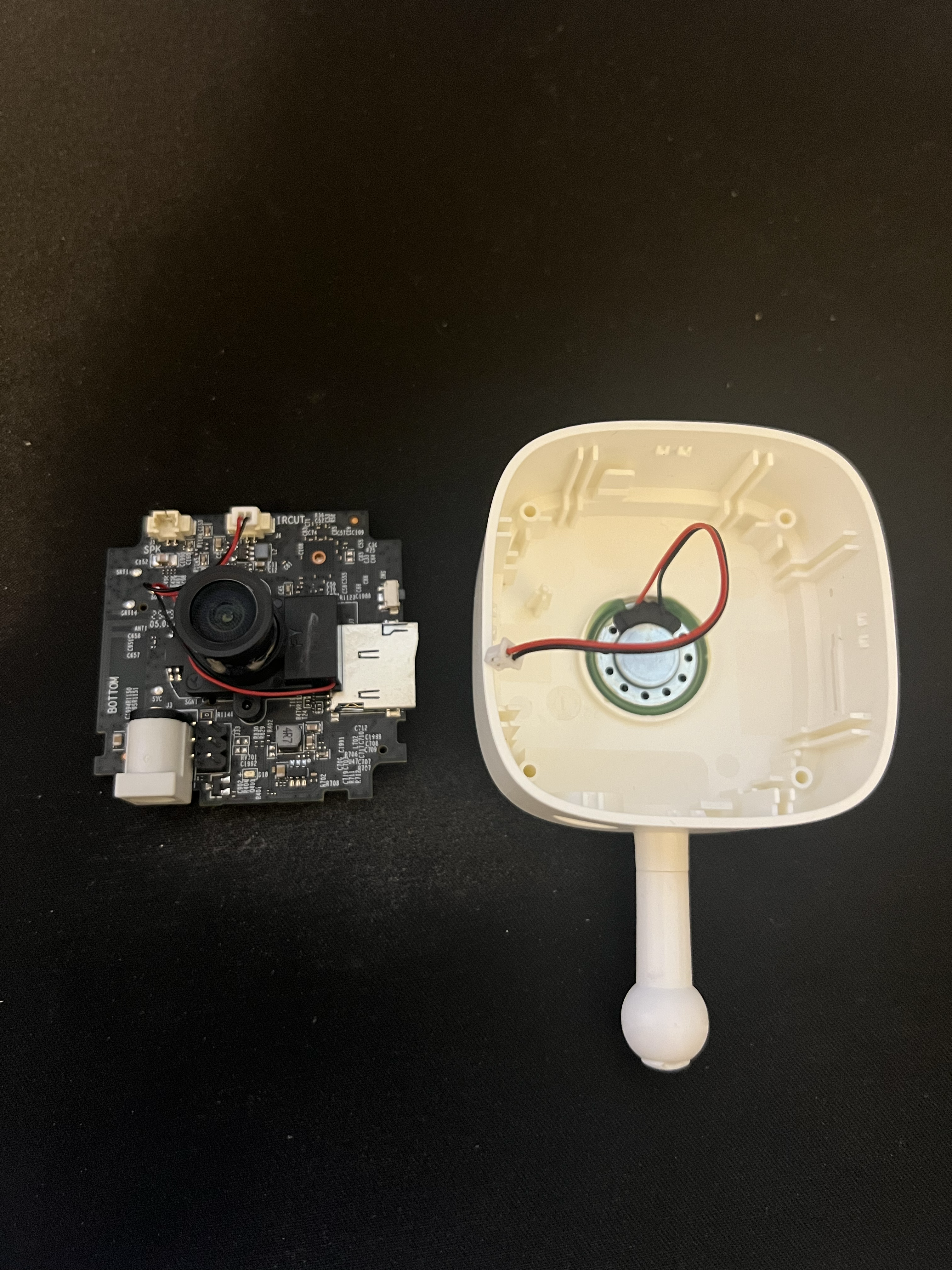
In order to access the flash memory, we need to remove the camera lens, as it covers the flash. On the other side of the chip are two screws which hold the lens in place. We can remove the screws, unplug the lens connector, and get the chip fully isolated.

C100 Hardware
Next, I wanted to figure out what kind of hardware there was. I knew in general the flash memory would be SOP8/SOIC8 package, but other than that, I didn’t know specifics of the C100.
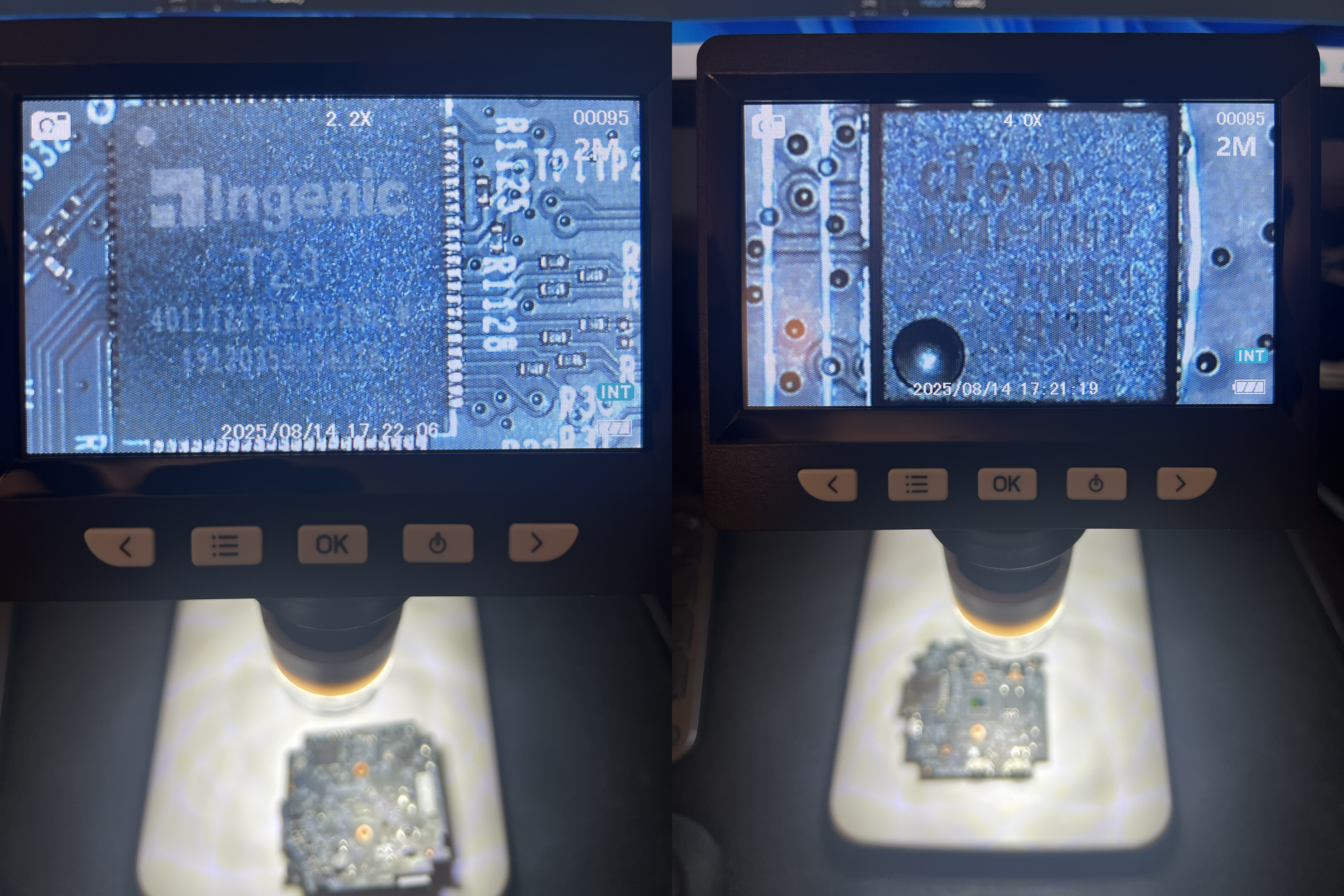 The SOC is an Ingenic T23 and the flash memory is a bit harder to identify. From what I can tell, it’s a CFeon QX64A(?). Because the flash memory is in SOP8/SOIC8 package, it should work with our CH341A programmer.
The SOC is an Ingenic T23 and the flash memory is a bit harder to identify. From what I can tell, it’s a CFeon QX64A(?). Because the flash memory is in SOP8/SOIC8 package, it should work with our CH341A programmer.
Dumping Flash
Next, I wanted to dump the flash. This took a bit of trial and error and a couple YouTube videos to showcase the CH341A and how it works. the TL;DR is that the red cable = pin 1, and so you need to line up the pin one on the clip with pin one on the chip. The CH341A also has different voltages, such as 5V, 3.3V, 1.8V, but as far as I can tell: it defaults to 5V, will level shift to 3.3V if it detects it’s needed, and 1.8V requires an adapter. I was a bit worried here because a lot of the Amazon reviews mentioned 5V killing 3.3V chips, but it looks like that was an older model that didn’t automatically level shift. Either way, I just lined up the pin one on the connector (red cable) with pin one on the chip (it has a circle), and then connected the connector to the CH341A chip. Another important note is to make sure you plug it into the SPI side (left side) of the CH341A and not the I2C (right side).
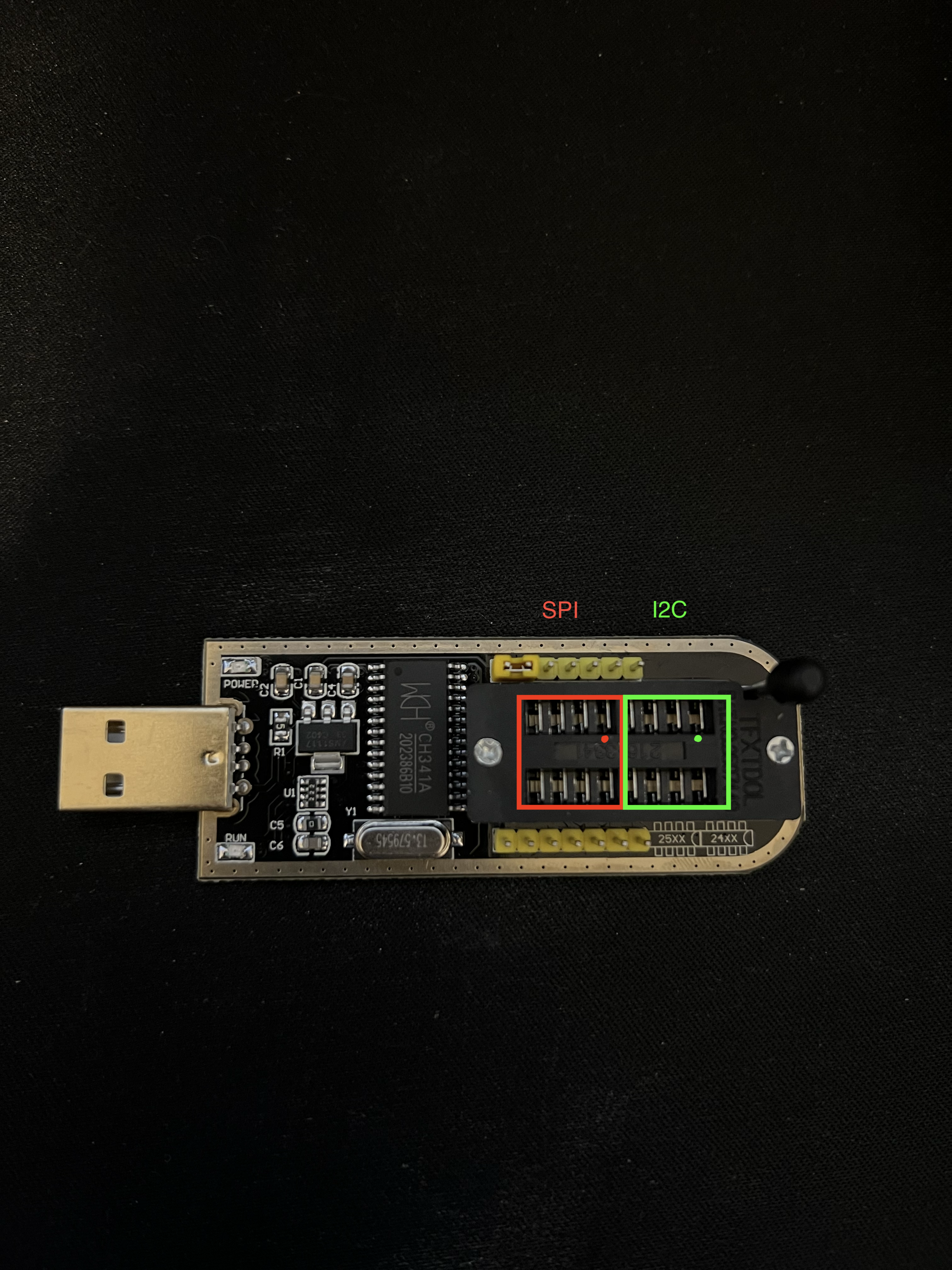
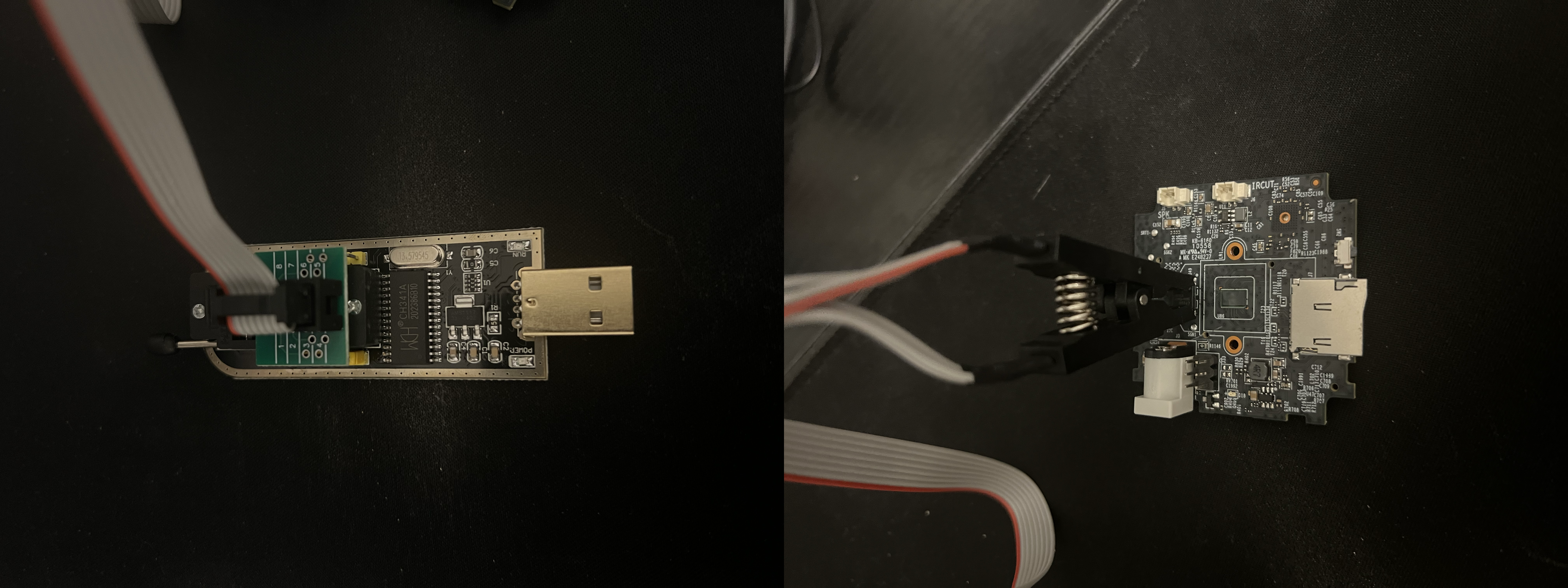
With the pins lined up correctly, we can then plug it into the USB port of our computer. At first, I tried macOS but got stuck in driver hell, so decided to switch to Kali Linux. On Kali, I first verified the device was showing up properly with lsusb:
lsusb
Bus 003 Device 019: ID 1a86:5512 QinHeng Electronics CH341 in EPP/MEM/I2C mode, EPP/I2C adapterThen, we can use flashrom to read the contents. For sanity sake, I ran this three times (backup.bin, backup2.bin, and backup3.bin):
flashrom -p ch341a_spi -r backup.bin
flashrom 1.4.0 on Linux 6.12.25-amd64 (x86_64) flashrom is free software, get the source code at https://flashrom.org === SFDP has autodetected a flash chip which is not natively supported by flashrom yet. All standard operations (read, verify, erase and write) should work, but to support all possible features we need to add them manually. You can help us by mailing us the output of the following command to [email protected]: 'flashrom -VV [plus the -p/--programmer parameter]' Thanks for your help! === Found Unknown flash chip "SFDP-capable chip" (8192 kB, SPI) on ch341a_spi. === This flash part has status UNTESTED for operations: WP The test status of this chip may have been updated in the latest development version of flashrom. If you are running the latest development version, please email a report to [email protected] if any of the above operations work correctly for you with this flash chip. Please include the flashrom log file for all operations you tested (see the man page for details), and mention which mainboard or programmer you tested in the subject line. You can also try to follow the instructions here: https://www.flashrom.org/contrib_howtos/how_to_mark_chip_tested.html Thanks for your help!Then, we can validate our dumps to ensure they’re consistent.
md5sum backup*
df76c5e9eb29934031d3cb6501c4144f backup2.bin
df76c5e9eb29934031d3cb6501c4144f backup3.bin
1494d17a9066bdcc89ba1037a2cf9995 backup.binSo, it looks like backup.bin might be corrupt, but backup2 and backup3 seem to be the proper flash dump. Next, I ran binwalk to get an idea of the layout:
binwalk backup2.bin
------------------------------------------------------------------------------------------------------------------------------
DECIMAL HEXADECIMAL DESCRIPTION
------------------------------------------------------------------------------------------------------------------------------
26624 0x6800 uImage firmware image, header size: 64 bytes, data
size: 82133 bytes, compression: lzma, CPU: MIPS32, OS:
Firmware, image type: Firmware Image, load address:
0x80100000, entry point: 0x0, creation time: 2024-06-17
11:22:53, image name: "u-boot-lzma.img"
196864 0x30100 gzip compressed data, operating system: Unix,
timestamp: 2024-06-17 11:24:57, total size: 53568 bytes
327680 0x50000 uImage firmware image, header size: 64 bytes, data
size: 66729 bytes, compression: lzma, CPU: MIPS32, OS:
Firmware, image type: Firmware Image, load address:
0x820A0000, entry point: 0x0, creation time: 2024-06-17
11:22:25, image name: "u-boot-lzma.img"
459264 0x70200 uImage firmware image, header size: 64 bytes, data
size: 1298384 bytes, compression: lzma, CPU: MIPS32,
OS: Linux, image type: OS Kernel Image, load address:
0x80010000, entry point: 0x8031E330, creation time:
2024-06-17 11:24:47, image name: "mips Ingenic
Linux-3.10.14"
1797686 0x1B6E36 XZ compressed data, total size: 30012 bytes
1827698 0x1BE372 XZ compressed data, total size: 31052 bytes
1858750 0x1C5CBE XZ compressed data, total size: 30800 bytes
1889550 0x1CD50E XZ compressed data, total size: 26280 bytes
1915830 0x1D3BB6 XZ compressed data, total size: 14656 bytes
1930486 0x1D74F6 XZ compressed data, total size: 17192 bytes
1947678 0x1DB81E XZ compressed data, total size: 14900 bytes
1962578 0x1DF252 XZ compressed data, total size: 10256 bytes
1972834 0x1E1A62 XZ compressed data, total size: 22512 bytes
1995346 0x1E7252 XZ compressed data, total size: 10248 bytes
2005594 0x1E9A5A XZ compressed data, total size: 21088 bytes
2026682 0x1EECBA XZ compressed data, total size: 6064 bytes
2032746 0x1F046A XZ compressed data, total size: 24208 bytes
2056954 0x1F62FA XZ compressed data, total size: 20504 bytes
2077458 0x1FB312 XZ compressed data, total size: 24384 bytes
2101842 0x201252 XZ compressed data, total size: 26244 bytes
2128086 0x2078D6 XZ compressed data, total size: 25180 bytes
2153266 0x20DB32 XZ compressed data, total size: 24180 bytes
2177446 0x2139A6 XZ compressed data, total size: 28316 bytes
2205762 0x21A842 XZ compressed data, total size: 26020 bytes
2231782 0x220DE6 XZ compressed data, total size: 25176 bytes
2256958 0x22703E XZ compressed data, total size: 16576 bytes
2273534 0x22B0FE XZ compressed data, total size: 35604 bytes
2309138 0x233C12 XZ compressed data, total size: 21800 bytes
2330938 0x23913A XZ compressed data, total size: 4604 bytes
2335542 0x23A336 XZ compressed data, total size: 18996 bytes
2354538 0x23ED6A XZ compressed data, total size: 21652 bytes
2376190 0x2441FE XZ compressed data, total size: 21024 bytes
2397214 0x24941E XZ compressed data, total size: 21376 bytes
2418590 0x24E79E XZ compressed data, total size: 17956 bytes
2436546 0x252DC2 XZ compressed data, total size: 22000 bytes
2458546 0x2583B2 XZ compressed data, total size: 37016 bytes
2495562 0x26144A XZ compressed data, total size: 21956 bytes
2517518 0x266A0E XZ compressed data, total size: 17040 bytes
2534558 0x26AC9E XZ compressed data, total size: 16120 bytes
2550678 0x26EB96 XZ compressed data, total size: 7060 bytes
2557738 0x27072A XZ compressed data, total size: 16020 bytes
2573758 0x2745BE XZ compressed data, total size: 23056 bytes
2596814 0x279FCE XZ compressed data, total size: 24236 bytes
2621050 0x27FE7A XZ compressed data, total size: 23652 bytes
2644702 0x285ADE XZ compressed data, total size: 26556 bytes
2671258 0x28C29A XZ compressed data, total size: 21624 bytes
2692882 0x291712 XZ compressed data, total size: 24600 bytes
2717482 0x29772A XZ compressed data, total size: 23036 bytes
2740518 0x29D126 XZ compressed data, total size: 27328 bytes
2767846 0x2A3BE6 XZ compressed data, total size: 22784 bytes
2790630 0x2A94E6 XZ compressed data, total size: 19700 bytes
2810330 0x2AE1DA XZ compressed data, total size: 19580 bytes
2829910 0x2B2E56 XZ compressed data, total size: 17024 bytes
2846934 0x2B70D6 XZ compressed data, total size: 16984 bytes
2863918 0x2BB32E XZ compressed data, total size: 20552 bytes
2884470 0x2C0376 XZ compressed data, total size: 22536 bytes
2907006 0x2C5B7E XZ compressed data, total size: 27980 bytes
2934986 0x2CC8CA XZ compressed data, total size: 23244 bytes
2958230 0x2D2396 XZ compressed data, total size: 21820 bytes
2980050 0x2D78D2 XZ compressed data, total size: 15392 bytes
2995442 0x2DB4F2 XZ compressed data, total size: 7056 bytes
3002498 0x2DD082 XZ compressed data, total size: 19808 bytes
3022306 0x2E1DE2 XZ compressed data, total size: 19644 bytes
3041950 0x2E6A9E XZ compressed data, total size: 21884 bytes
3063834 0x2EC01A XZ compressed data, total size: 22964 bytes
3086798 0x2F19CE XZ compressed data, total size: 34616 bytes
3121414 0x2FA106 XZ compressed data, total size: 17448 bytes
3138862 0x2FE52E XZ compressed data, total size: 14780 bytes
3153642 0x301EEA XZ compressed data, total size: 4824 bytes
3158466 0x3031C2 XZ compressed data, total size: 19040 bytes
3177506 0x307C22 XZ compressed data, total size: 22628 bytes
3200134 0x30D486 XZ compressed data, total size: 21988 bytes
3222122 0x312A6A XZ compressed data, total size: 23636 bytes
3245758 0x3186BE XZ compressed data, total size: 22696 bytes
3268454 0x31DF66 XZ compressed data, total size: 1124 bytes
3269578 0x31E3CA XZ compressed data, total size: 26400 bytes
3295978 0x324AEA XZ compressed data, total size: 9704 bytes
3305682 0x3270D2 XZ compressed data, total size: 14944 bytes
3320626 0x32AB32 XZ compressed data, total size: 32800 bytes
3353426 0x332B52 XZ compressed data, total size: 784 bytes
3354210 0x332E62 XZ compressed data, total size: 17936 bytes
3372146 0x337472 XZ compressed data, total size: 25024 bytes
3397170 0x33D632 XZ compressed data, total size: 25140 bytes
3422310 0x343866 XZ compressed data, total size: 24472 bytes
3446782 0x3497FE XZ compressed data, total size: 28164 bytes
3474946 0x350602 XZ compressed data, total size: 27360 bytes
3502306 0x3570E2 XZ compressed data, total size: 20920 bytes
3523226 0x35C29A XZ compressed data, total size: 18724 bytes
3541950 0x360BBE XZ compressed data, total size: 9124 bytes
3551074 0x362F62 XZ compressed data, total size: 11628 bytes
3562702 0x365CCE XZ compressed data, total size: 15200 bytes
3577902 0x36982E XZ compressed data, total size: 23956 bytes
3601860 0x36F5C4 XZ compressed data, total size: 1668 bytes
3603530 0x36FC4A XZ compressed data, total size: 1652 bytes
3605184 0x3702C0 XZ compressed data, total size: 3724 bytes
3608910 0x37114E XZ compressed data, total size: 580 bytes
3609492 0x371394 XZ compressed data, total size: 152 bytes
3609654 0x371436 XZ compressed data, total size: 884 bytes
3997696 0x3D0000 SquashFS file system, little endian, version: 4.0,
compression: xz, inode count: 95, block size: 65536,
image size: 3225548 bytes, created: 2024-06-17 11:24:55
7224524 0x6E3CCC gzip compressed data, operating system: Unix,
timestamp: 2024-06-17 11:24:57, total size: 53568 bytes
7798784 0x770000 JFFS2 filesystem, little endian, nodes: 18, total size:
491532 bytesNow, we’re not sure of the exact partition layout, but a rough estimate could be
| Start | End | Name |
|---|---|---|
| 0x000000 | 0x04FFFF | factory_boot |
| 0x050000 | 0x06FFFF | boot |
| 0x070000 | 0x3CFFFF | kernel |
| 0x3D0000 | 0x76FFFF | rootfs |
| 0x770000 | 0x7FFFFF | data |
Lastly, we can use binwalk again to extract all of these. At this point, I switched back to macOS and had to use the new binwalk (rust based) instead of the standard Kali Python3 version. My syntax here may differ, but for completeness sake, I will provide both v2/v3 commands. Also make sure you install jefferson via pip and unsquashfs/sasquatch for jffs2 and squashfs extractor support. |
binwalk -e --dd=".*" backup2.bin
binwalk -e backup2.binAgain, the way binwalk works differs from v2 and v3. On v2, it’s a flat file structure, on v3, it’s directory based.. which kinda sucks.
tree
.
├── 1B6E36
│ └── decompressed.bin
├── 1BE372
│ └── decompressed.bin
├── 1C5CBE
│ └── decompressed.bin
├── 1CD50E
│ └── decompressed.bin
├── 1D3BB6
│ └── decompressed.bin
├── 1D74F6
│ └── decompressed.bin
├── 1DB81E
│ └── decompressed.bin
├── 1DF252
│ └── decompressed.bin
├── 1E1A62
│ └── decompressed.bin
├── 1E7252
│ └── decompressed.bin
├── 1E9A5A
│ └── decompressed.bin
├── 1EECBA
│ └── decompressed.bin
├── 1F046A
│ └── decompressed.bin
├── 1F62FA
│ └── decompressed.bin
├── 1FB312
│ └── decompressed.bin
├── 201252
│ └── decompressed.bin
├── 2078D6
│ └── decompressed.bin
├── 20DB32
│ └── decompressed.bin
├── 2139A6
│ └── decompressed.bin
├── 21A842
│ └── decompressed.bin
├── 220DE6
│ └── decompressed.bin
├── 22703E
│ └── decompressed.bin
├── 22B0FE
│ └── decompressed.bin
├── 233C12
│ └── decompressed.bin
├── 23913A
│ └── decompressed.bin
├── 23A336
│ └── decompressed.bin
├── 23ED6A
│ └── decompressed.bin
├── 2441FE
│ └── decompressed.bin
├── 24941E
│ └── decompressed.bin
├── 24E79E
│ └── decompressed.bin
├── 252DC2
│ └── decompressed.bin
├── 2583B2
│ └── decompressed.bin
├── 26144A
│ └── decompressed.bin
├── 266A0E
│ └── decompressed.bin
├── 26AC9E
│ └── decompressed.bin
├── 26EB96
│ └── decompressed.bin
├── 27072A
│ └── decompressed.bin
├── 2745BE
│ └── decompressed.bin
├── 279FCE
│ └── decompressed.bin
├── 27FE7A
│ └── decompressed.bin
├── 285ADE
│ └── decompressed.bin
├── 28C29A
│ └── decompressed.bin
├── 291712
│ └── decompressed.bin
├── 29772A
│ └── decompressed.bin
├── 29D126
│ └── decompressed.bin
├── 2A3BE6
│ └── decompressed.bin
├── 2A94E6
│ └── decompressed.bin
├── 2AE1DA
│ └── decompressed.bin
├── 2B2E56
│ └── decompressed.bin
├── 2B70D6
│ └── decompressed.bin
├── 2BB32E
│ └── decompressed.bin
├── 2C0376
│ └── decompressed.bin
├── 2C5B7E
│ └── decompressed.bin
├── 2CC8CA
│ └── decompressed.bin
├── 2D2396
│ └── decompressed.bin
├── 2D78D2
│ └── decompressed.bin
├── 2DB4F2
│ └── decompressed.bin
├── 2DD082
│ └── decompressed.bin
├── 2E1DE2
│ └── decompressed.bin
├── 2E6A9E
│ └── decompressed.bin
├── 2EC01A
│ └── decompressed.bin
├── 2F19CE
│ └── decompressed.bin
├── 2FA106
│ └── decompressed.bin
├── 2FE52E
│ └── decompressed.bin
├── 30100
│ └── decompressed.bin
├── 301EEA
│ └── decompressed.bin
├── 3031C2
│ └── decompressed.bin
├── 307C22
│ └── decompressed.bin
├── 30D486
│ └── decompressed.bin
├── 312A6A
│ └── decompressed.bin
├── 3186BE
│ └── decompressed.bin
├── 31DF66
│ └── decompressed.bin
├── 31E3CA
│ └── decompressed.bin
├── 324AEA
│ └── decompressed.bin
├── 3270D2
│ └── decompressed.bin
├── 32AB32
│ └── decompressed.bin
├── 332B52
│ └── decompressed.bin
├── 332E62
│ └── decompressed.bin
├── 337472
│ └── decompressed.bin
├── 33D632
│ └── decompressed.bin
├── 343866
│ └── decompressed.bin
├── 3497FE
│ └── decompressed.bin
├── 350602
│ └── decompressed.bin
├── 3570E2
│ └── decompressed.bin
├── 35C29A
│ └── decompressed.bin
├── 360BBE
│ └── decompressed.bin
├── 362F62
│ └── decompressed.bin
├── 365CCE
│ └── decompressed.bin
├── 36982E
│ └── decompressed.bin
├── 36F5C4
│ └── decompressed.bin
├── 36FC4A
│ └── decompressed.bin
├── 3702C0
│ └── decompressed.bin
├── 37114E
│ └── decompressed.bin
├── 371394
│ └── decompressed.bin
├── 371436
│ └── decompressed.bin
├── 3D0000
│ └── squashfs-root
│ ├── bin
│ │ ├── dmesg -> busybox
│ │ ├── gdbserver
│ │ ├── getcpuinfo
│ │ ├── impdbg
│ │ ├── logcat
│ │ └── main
│ ├── config
│ │ └── auto_detect_sensor
│ │ ├── detect_i2c_install_sensor.sh
│ │ ├── modules
│ │ │ └── sensor_sc2336p_t23.ko
│ │ └── sensor_db.cfg
│ ├── etc
│ │ ├── OSD
│ │ │ ├── angle2560x1920.bin
│ │ │ ├── angle960P.bin
│ │ │ ├── logo1080P.bin
│ │ │ ├── logo2304x1296.bin
│ │ │ ├── logo2560x1440.bin
│ │ │ ├── logo2688x1520.bin
│ │ │ ├── logo360P.bin
│ │ │ ├── logo720P.bin
│ │ │ ├── time1080P.bin
│ │ │ ├── time2304x1296.bin
│ │ │ ├── time2560x1440.bin
│ │ │ ├── time360P.bin
│ │ │ └── time720P.bin
│ │ ├── data
│ │ │ └── dss_certificates
│ │ │ ├── StarfieldClass2CertificationAuthority.pem
│ │ │ └── dpss_public_key.pem
│ │ ├── default_isp
│ │ │ └── sc2336p-t23.bin
│ │ ├── dnsd.conf
│ │ ├── dsd_convert.json
│ │ ├── hw_id.bin
│ │ ├── isp_extra
│ │ │ └── sc2336p-factorymode-t23.bin
│ │ ├── plugins
│ │ │ ├── icassp8k_opt.bin
│ │ │ ├── icassp8k_opt_param.bin
│ │ │ └── icassp_opt.bin.dsc
│ │ ├── sensor -> /tmp/base-files/cfg
│ │ ├── uhttpd.crt
│ │ ├── uhttpd.key
│ │ └── webrtc_profile.ini
│ ├── lib
│ │ ├── audio
│ │ │ ├── Emergency.g711
│ │ │ ├── Red_Alert.g711
│ │ │ ├── Siren.g711
│ │ │ ├── motion_deteck_alarm.g711
│ │ │ ├── motion_deteck_cue.g711
│ │ │ ├── prompt_tone_failed.g711
│ │ │ ├── prompt_tone_sucess.g711
│ │ │ ├── register_success.g711
│ │ │ ├── reset_success.g711
│ │ │ ├── sd_abnormal.g711
│ │ │ ├── sd_not_formated.g711
│ │ │ ├── sweep_frequency.g711
│ │ │ ├── wlan_state_connect_suc.g711
│ │ │ ├── wlan_state_connecting.g711
│ │ │ ├── wlan_state_get_ip_fail.g711
│ │ │ ├── wlan_state_mode_switch_suc.g711
│ │ │ └── wlan_state_password_err.g711
│ │ ├── load_isp_data
│ │ └── modules
│ │ └── 3.10.14
│ │ ├── audio.ko
│ │ ├── esp32.ko
│ │ ├── jzmmc_v12.ko
│ │ ├── mmc_block.ko
│ │ ├── mmc_core.ko
│ │ ├── sinfo.ko
│ │ └── tx-isp-t23.ko
│ └── usr
│ ├── bin
│ │ ├── iperf
│ │ ├── is_cal_real.script
│ │ ├── song-16-gb2312.bin
│ │ └── tail -> ../../bin/busybox
│ ├── lib
│ │ ├── libaudioProcess.so
│ │ ├── libstdc++.so.6 -> libstdc++.so.6.0.21
│ │ ├── libstdc++.so.6.0.21
│ │ └── libudt.so
│ └── sbin
│ ├── chroot -> ../../bin/busybox
│ ├── dnsd -> ../../bin/busybox
│ ├── fatlabel
│ ├── fsck.fat
│ ├── hostapd
│ └── mkfs.fat
├── 50000
│ └── u-boot-lzma.img.bin
├── 6800
│ └── u-boot-lzma.img.bin
├── 6E3CCC
│ └── decompressed.bin
├── 70200
│ └── mips_Ingenic_Linux-3.10.14.bin
└── 770000
└── jffs2-root
└── jffs2Either way, at this point, we’ve now extracted uboot, the kernel, rootfs, and an overlay.
Cracking the Hash
Before trying to get UART, we should be prepared for a password. From my prior reading on C200 hacking, the login was root:slprealtek. I also found some references to slplzgjipc and slpmstar as passwords from this GitHub discussion. Let’s try to find the hash with a simple grep:
grep -arin "^root:" .
./1E1A62/decompressed.bin:365:root:$1$lI7mZm78$dA8pGGOerrGJXj7Tp2yQg/:0:0:root:/root:/bin/ash
./1E1A62/decompressed.bin:836:root:x:0:0:99999:7:::Pretty easy: $1$lI7mZm78$dA8pGGOerrGJXj7Tp2yQg/. At first, I created a simple wordlist containing the previously seen before password candidates and used hashcat to try and crack it— however, this didn’t crack. So, it’s using a (so far) undocumented password. Based on the past candidates, it looks like it uses the slp prefix and then a-z. I had a friend with an RTX 5070 Ti attempt to crack the hash using hashcat, since my Macbook probably would have taken a while.
hashcat -m 500 '$1$lI7mZm78$dA8pGGOerrGJXj7Tp2yQg/' -a 3 'slp?1?1?1?1?1?1?1' --custom-charset1=ABCDEFGHIJKLMNOPQRSTUVWXYZabcdefghijklmnopqrstuvwxyz
$1$lI7mZm78$dA8pGGOerrGJXj7Tp2yQg/:slpingenic
Session..........: hashcat
Status...........: Cracked
Hash.Mode........: 500 (md5crypt, MD5 (Unix), Cisco-IOS $1$ (MD5))
Hash.Target......: $1$lI7mZm78$dA8pGGOerrGJXj7Tp2yQg/
Time.Started.....: Thu Aug 14 20:37:06 2025 (52 mins, 6 secs)
Time.Estimated...: Thu Aug 14 21:29:12 2025 (0 secs)
Kernel.Feature...: Optimized Kernel
Guess.Mask.......: slp?1?1?1?1?1?1?1 [10]
Guess.Charset....: -1 ABCDEFGHIJKLMNOPQRSTUVWXYZabcdefghijklmnopqrstuvwxyz, -2 Undefined, -3 Undefined, -4 Undefined
Guess.Queue......: 1/1 (100.00%)
Speed.#1.........: 29562.2 kH/s (8.48ms) @ Accel:32 Loops:1000 Thr:128 Vec:1
Speed.#2.........: 613.3 kH/s (6.18ms) @ Accel:1024 Loops:125 Thr:32 Vec:1
Speed.#*.........: 30175.4 kH/s
Recovered........: 1/1 (100.00%) Digests (total), 1/1 (100.00%) Digests (new)
Progress.........: 100396195840/1028071702528 (9.77%)
Rejected.........: 0/100396195840 (0.00%)
Restore.Point....: 100393615360/1028071702528 (9.77%)
Restore.Sub.#1...: Salt:0 Amplifier:0-1 Iteration:0-1000
Restore.Sub.#2...: Salt:0 Amplifier:0-1 Iteration:625-750
Candidate.Engine.: Device Generator
Candidates.#1....: slprNALIOM -> slpWpamiso
Candidates.#2....: slpkMpKIOM -> slpvUxKIOM
Hardware.Mon.#1..: Temp: 65c Fan: 56% Util: 97% Core:2775MHz Mem:14001MHz Bus:16
Hardware.Mon.#2..: Temp: 0c Fan: 0% Util: 85% Core: 600MHz Mem:2400MHz Bus:16
Started: Thu Aug 14 20:36:59 2025
Stopped: Thu Aug 14 21:29:14 2025We get the password: slpingenic. To be fair, I probably could have reduced the alphabet to just lowercase instead of A-z and ran it myself, but I rather need to try to use hashcat once than twice :^). And it only took 52 minutes— not bad! (shoutout carter). Another interesting thing here (which I should have realized earlier) is the password convention seems to follow slp<name of processor>. In C200, it’s slprealtek, there was a reference to mstar which is another chip, and then in our case, ingenic which references in the Ingenic T23.
UART Shell
The next step is to pop a shell via UART. I kind of pushed this off to last, because well, we didn’t know the password.. but also, it requires soldering which I had never done.
 We can identify 4 test pads: probably VCC/GND/TX/RX (in an unknown order). The first step is to identify which pin is which. In general, this can be determined using a multimeter in DC mode.
We can identify 4 test pads: probably VCC/GND/TX/RX (in an unknown order). The first step is to identify which pin is which. In general, this can be determined using a multimeter in DC mode.
VCC = Constant voltage (e.g. 3.3V)
GND = 0V
RX = Constant for the most part
TX = Fluctuates at boot because logging over serial
We just need to test each pin’s voltage during the boot process. I powered on my multimeter, set it to 20DC and attached the black probe to a ground (in this case, the copper around where the lens screws used to be) and attached red to each pin. From my testing:
PIN 1 = 3.28
PIN 2 = 0.00
PIN 3 = 3.27
PIN 4 = Fluctation, ends at 3.27
So, a probable guess would be VCC/GND/RX/TX. It’s possible VCC and RX are swapped, but Usually RX and TX will be beside each other: RX/GND/VCC/TX ordering doesn’t make too much sense. Now, we just need to solder some wires onto the test pads so we can connect our DuPont wires and our USB to UART adapter. My CH341A came with some pin headers, and so I figured I could snap them apart using scissors to get individual pins and solder those on. However, the black casing (2.54mm) was too wide for the pads and wouldn’t allow me to align all 4 pins onto the pads. So, I used some pliers to crush the black plastic housing, and then grabbed the metal while using my fingers to pull down the black housing.
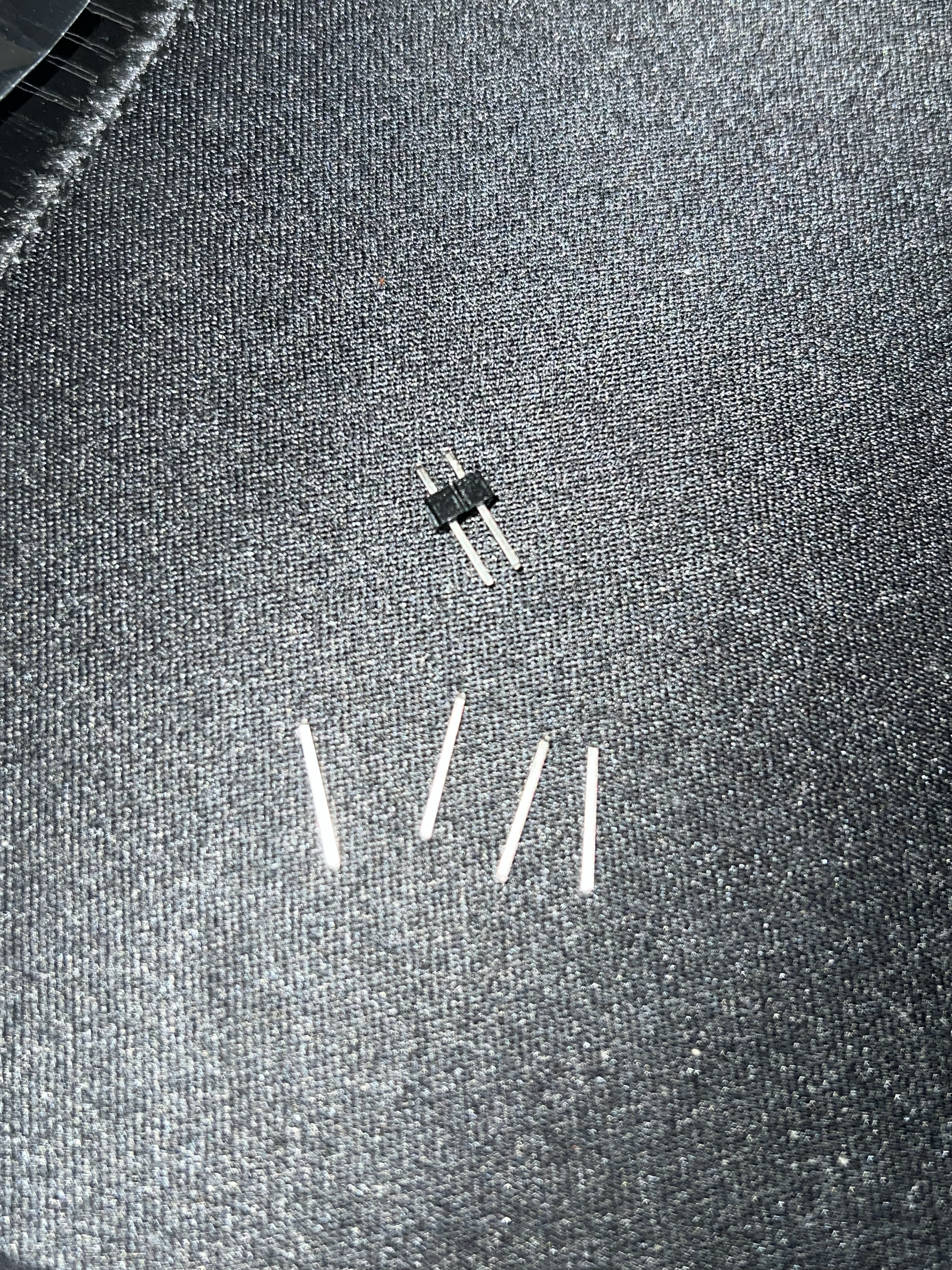
This allowed me to turn my standard header pins into individual, bare pins. I’m not sure if this was the best method, or if there’s some other preferred method to connecting to test pads, but oh well. If anyone knows the right answer, please reach out :).
Unfortunately, at this point I had to break away from my beginner kit and add some additional items, including a soldering iron, solder, flux, desoldering braid, and other standard soldering station items.
With my new soldering gear, I was ready to take on the task! … Until, I accidentally pulled up one of the solder pads. And so, that idea failed and I had to buy another camera.
For attempt #2, I learned from my mistakes. The pin idea would have been nice, but trying to align something vertically on a really small pad is insanely hard— especially for someone who has never soldered before. Instead, I decided to just use my male-to-male DuPont wires, cut off one end’s connector, and strip a bit of the wire using 28 gauge wire strippers. Then, I was able to more easily solder onto the pads. Also, this time I used flux and it was almost an immediate difference how easy it was. Highly recommend.
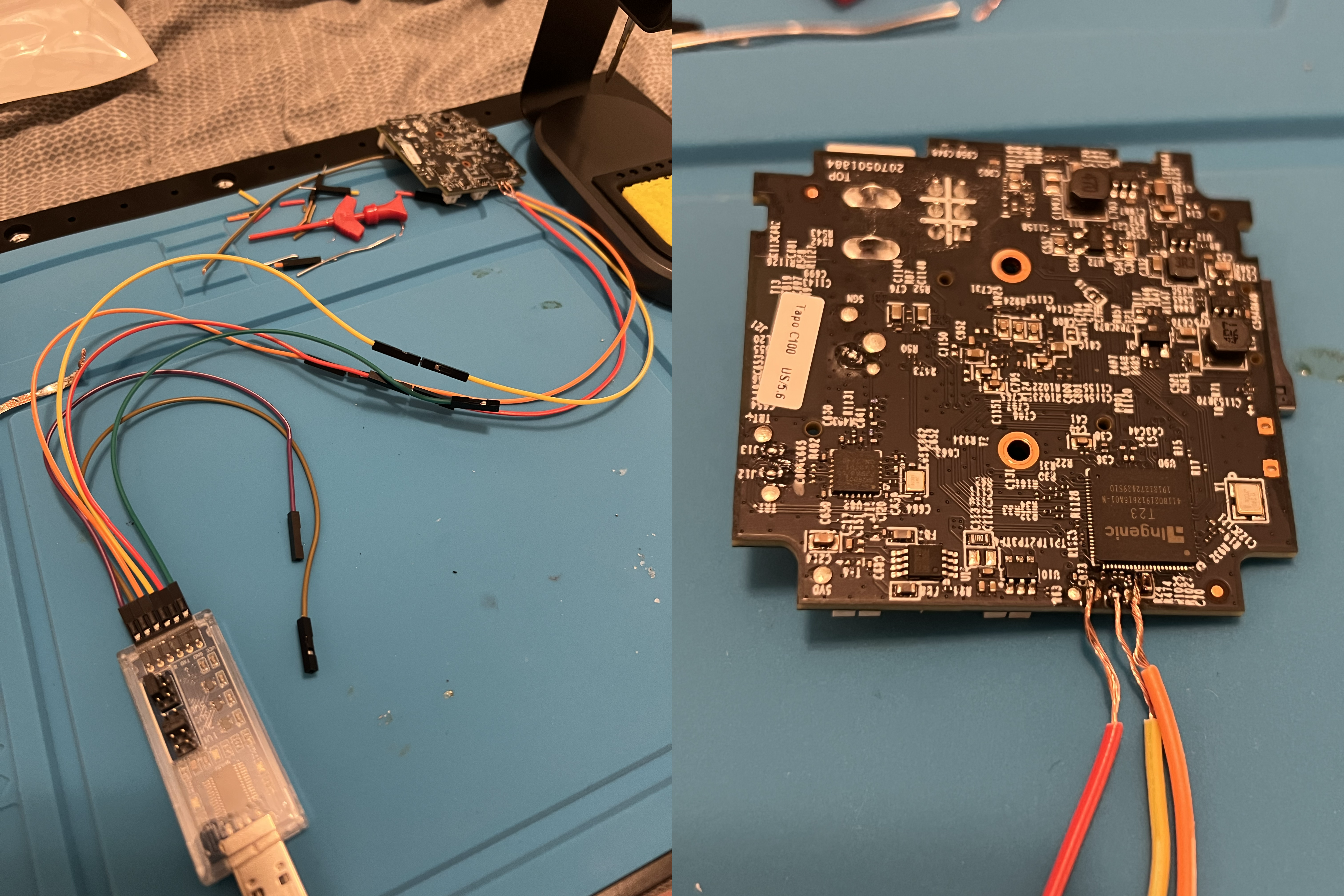 It should be worth mentioning that when connecting to UART:
It should be worth mentioning that when connecting to UART:
- ground = ground
- TX on the board = RX on the adapter
- RX on the board = TX on the adapter
Then, I was able to use screen with a baud rate 115200 to connect to UART :)
screen /dev/ttyUSB0 115200
U-Boot SPL 2013.07 (Jun 17 2024 - 19:22:26)
Board info: T23N
apll_freq = 1200000000
mpll_freq = 1176000000
sdram init start
DDR clk rate 588000000
DDR_PAR of eFuse: 00000000 00000000
sdram init finished
image entry point: 0x80100000
U-Boot 2013.07 (Jun 17 2024 - 19:22:26)
Board: ISVP (Ingenic XBurst T23 SoC)
DRAM: 64 MiB
Top of RAM usable for U-Boot at: 84000000
Reserving 425k for U-Boot at: 83f94000
Reserving 32784k for malloc() at: 81f90000
Reserving 32 Bytes for Board Info at: 81f8ffe0
Reserving 124 Bytes for Global Data at: 81f8ff64
Reserving 128k for boot params() at: 81f6ff64
Stack Pointer at: 81f6ff48
Now running in RAM - U-Boot at: 83f94000
MMC: msc: 0
the manufacturer 1c
SF: Detected EN25QX64A
*** Warning - bad CRC, using default environment
In: serial
Out: serial
Err: serial
gpio_request lable = ir_cut gpio = 57
Net: No ethernet found.
Autobooting in 1 seconds
Firmware check pass!
cmd_buf = sf probe;sf read 0x80600000 0x50000 0x20000
the manufacturer 1c
SF: Detected EN25QX64A
--->probe spend 4 ms
SF: 131072 bytes @ 0x50000 Read: OK
--->read spend 47 ms
ret = 0, dst_len = 167096
cmd_buf = go 0x820a0000
## Starting application at 0x820A0000 ...
Flush cache all before jump.
U-Boot 2013.07 (Jun 17 2024 - 19:21:57)
Board: ISVP (Ingenic XBurst T23 SoC)
DRAM: 64 MiB
Top of RAM usable for U-Boot at: 84000000
Reserving 186k for U-Boot at: 83fd0000
Reserving 32784k for malloc() at: 81fcc000
Reserving 32 Bytes for Board Info at: 81fcbfe0
Reserving 124 Bytes for Global Data at: 81fcbf64
Reserving 128k for boot params() at: 81fabf64
Stack Pointer at: 81fabf48
Now running in RAM - U-Boot at: 83fd0000
MMC: msc: 0
the manufacturer 1c
SF: Detected EN25QX64A
*** Warning - bad CRC, using default environment
In: serial
Out: serial
Err: serial
gpio_request lable = ir_cut gpio = 57
VF: validateFirmwareWithRecover: copying flash to 0x22000000
the manufacturer 1c
SF: Detected EN25QX64A
--->probe spend 5 ms
SF: 8388608 bytes @ 0x0 Read: OK
--->read spend 2742 ms
VF: validateFirmwareWithRecover: ret=0(81fabe38)
VF: validateFirmwareWithRecover: validate local firmware...
TP Header at 22070000
set bootargs to earlyprintk console=ttyS1,115200n8 mem=42M@0x0 rmem=22M@0x2a00000 rootwait nprofile_irq_duration=on rootfstype=squashfs ro mtdparts=spi_nor.0 root=/dev/mtdblock6 rw spdev=/dev/mtdblock7 noinitrd init=/etc/preinit
the manufacturer 1c
SF: Detected EN25QX64A
--->probe spend 4 ms
SF: 2097152 bytes @ 0x70200 Read: OK
--->read spend 689 ms
## Booting kernel from Legacy Image at 80600000 ...
Image Name: mips Ingenic Linux-3.10.14
Image Type: MIPS Linux Kernel Image (lzma compressed)
Data Size: 1298384 Bytes = 1.2 MiB
Load Address: 80010000
Entry Point: 8031e330
Verifying Checksum ... OK
Uncompressing Kernel Image ... OK
Starting kernel ...From the resources I found on the C200 model, they mentioned two U-boot stages, and dropping a shell required typing slp on the second autoboot. I never encountered a second autoboot— just one that booted into the kernel.
Device Rooted
There are two ways to get root. The first is through the normal boot process. It’s a bit hectic, since you’ll see random debugging messages, but if you wait until most of the booting process is done, you can press ‘Enter’ a couple of times to get a login prompt. We can use the credentials we found earlier: root:slpingenic to drop into a shell.
un 17 19:24:47 login[117]: root login on 'ttyS1'
BusyBox v1.19.4 (2024-06-17 19:22:15 CST) built-in shell (ash)
Enter 'help' for a list of built-in commands.
SSSSSSSSSSSSSSSS LLLLLLLLLLLLLL PPPPPPPPPPPPPPPPPPPPPP
SSSSSSSSSSSSSSSSSS LLLLLLLLLLLLLL PPPPPPPPPPPPPPPPPPPPPPPP
SSSSSS SSSSSSSS LLLLLL PPPPPP PPPPPPPP
SSSSSS SSSSSS LLLLLL PPPPPP PPPPPP
SSSSSSSS SSSS LLLLLL PPPPPP PPPPPP
SSSSSSSSSSSSSS LLLLLL PPPPPP PPPPPPPP
SSSSSSSSSSSSSSSS LLLLLL PPPPPPPPPPPPPPPPPPPP
SSSSSSSSSSSSSS LLLLLL PPPPPPPPPPPPPPPP
SSSS SSSSSSSSSS LLLLLL LL PPPPPP
SSSSSS SSSSSS LLLLLL LLLLLL PPPPPP
SSSSSSSS SSSSSS [ 5.782579] misc sinfo_release
LLLLLL LLLL PPPPPP
SSSSSSSS SSSSSSSS LLLLLL LLLLLLLL PPPPPP
SSSSSSSSSSSSSSSSSSSS LLLLLLLLLLLLLLLLLLLLLLLL PPPPPPPPPPPPPP
SSSS SSSSSSSSSS LLLLLLLLLLLLLLLLLLLLLL PPPPPPPPPPPPPP
-------------------------------------------------------------------------------
SMARTs, the power to be your best! (torchlight: svn unknown)
-------------------------------------------------------------------------------
root@(c100v5):~# id
uid=0(root) gid=0(root) groups=0(root)The second is by interrupting the U-boot process and overriding bootargs and dropping us into the kernel directory. From the boot logs, we can see:
Booting kernel from Legacy Image at 80600000 ... Starting kernel ... [ 0.000000] Memory: 38000k/43008k available (3160k kernel code, 5008k reserved, 619k data, 184k init, 0k highmem) [ 0.658685] 0x000000070200-0x0000001b0000 : "kernel" [ 0.663866] mtd: partition "kernel" doesn't start on an erase block boundary -- force read-only [ 0.889661] Freeing unused kernel memory: 184K (803c2000 - 803f0000)
The default bootargs is:
isvp_t23# printenv
baudrate=115200
bootargs=console=ttyS1,115200n8 mem=41M@0x0 rmem=23M@0x2900000 noinitrd init=/etc/preinit rootfstype=squashfs root=/dev/mtdblock6 rw
bootdelay=1
bootfile=uImage
ethaddr=00:00:23:34:45:68
gatewayip=192.168.0.1
ipaddr=192.168.0.60
loadaddr=0x80600000
loads_echo=1
netmask=255.255.255.0
serverip=192.168.1.100
stderr=serial
stdin=serial
stdout=serialSo, it’s attempting to execute /etc/preinit. We can modify init to be /bin/sh using setenv bootargs 'console=ttyS1,115200n8 mem=41M@0x0 rmem=23M@0x2900000 noinitrd rootfstype=squashfs root=/dev/mtdblock6 rw init=/bin/sh'. Then, we just need to load the kernel:
isvp_t23# setenv bootargs 'console=ttyS1,115200n8 mem=41M@0x0 rmem=23M@0x2900000 noinitrd rootfstype=squashfs root=/dev/mtdblock6 rw init=/bin/sh'
isvp_t23# sf probe
the manufacturer 1c
SF: Detected EN25QX64A
--->probe spend 5 ms
isvp_t23# sf read ${loadaddr} 0x70200 0x200000
SF: 2097152 bytes @ 0x70200 Read: OK
--->read spend 688 ms
isvp_t23# bootm ${loadaddr}
## Booting kernel from Legacy Image at 80600000 ...
Image Name: mips Ingenic Linux-3.10.14
Image Type: MIPS Linux Kernel Image (lzma compressed)
Data Size: 1298384 Bytes = 1.2 MiB
Load Address: 80010000
Entry Point: 8031e330
Verifying Checksum ... OK
Uncompressing Kernel Image ... OK
Starting kernel ...
[ 0.000000] Linux version 3.10.14 (root@smartlifeci1) (gcc version 5.4.0 (Ingenic Ingenic r3.3.0-gcc540 Smaller Size 2023.05-22) ) #1 PREEMPT Mon Jun 17 19:24:44 CST 2024
[ 0.000000] CPU0 RESET ERROR PC:8B130304
[ 0.000000] CPU0 revision is: 00d00100 (Ingenic Xburst)
[ 0.000000] FPU revision is: 00b70000
[ 0.000000] cgu_vpu clk should be opened!
...
BusyBox v1.19.4 (2024-06-17 19:22:15 CST) built-in shell (ash)
Enter 'help' for a list of built-in commands.
/bin/sh: can't access tty; job control turned off
/ # [ 1.370372] usb 1-1: new high-speed USB device number 2 using dwc2
ls
bin etc mnt proc root sp_rom tmp var
dev lib moverlay rom msbin sys usr www
/ # id
uid=0(root) gid=0(root)
/ # The preferred method would be the first shell that requires a password, as that one will boot with /etc/preinit and initialize all processes used by the camera. Otherwise, if your goal is to see (for example) processes, open ports, etc., you won’t have that with overwriting the U-boot sequence.
